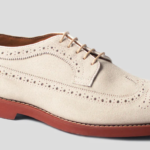We continue our exploration of the double-breasted jacket’s place in the Ivy genre with these recollections from King Richard XLIV.
* * *
The best-selling blazer in J. Press history was gathered by its roots from Aunt Florence.
Irving Press’s spouse was a lady who lunched at the fringes of La Cote Basque and other spots alongside Babe Paley, the Duchess d’Uzes, and other paradigms of ’60s New York Society. The reefer twill luncheon suit she wore on several occasions prompted a suggestion of versatiltiy she imparted to her husband: her suit might just be just the right material to make into a men’s blazer. Irving retrieved a swatch of the cloth from the dressmaker for Seymour Landsman, a principal at Linett, prime clothing provider to both Chipp and J. Press. “Get a hold of this material,” he commanded Landsman, “make it into a blazer, and confine it to J. Press.”
Adhering to the times, J. Press got high in the ’60s on Reefer Twill (the catalog image above is from 1969). The maritime history of the fabric was peacoat British, but the version J. Press devised featured distinctly rough-hewn, steep-ribbed twill, a startling departure from the soft hand of the flannel blazer classic. My personal favorite was a double-breasted forest green that flaunted two rows of Dartmouth buttons, but the preference of most Squeeze customers was the traditional single-breasted in navy.
Double-breasted suits and blazers at J. Press were tailored in the natural-shoulder style of our three-button model that departed from the single breasted version only via deep side vents. Reefer twill blazers were lined throughout in strident regimental striped Bemberg. Double-breasted suits and blazers never gained more than 10% advocacy at J. Press, but allowed us a response to detractors who called us stodgy and unbending.
In 1962, J. Press even attempted a foray into womenswear in our newly enlarged downstairs quarters on Forty-Fourth Street. The effort achieved scant success and quietly disappeared the following year.
Six degrees of separation, the merchandising and design savvy of a woman, the boss’s wife, inspired the greatest J. Press hit of the decade. — RICHARD PRESS











In spite of Mr. Press’ detailed description, I find myself unable to visualize exactly what “reefer twill” is. Can anybody provide a link to a clear photo of this particular cloth? Googling has not turned up anything that helps.
“Rough, steep-ribbed twill”: I saw something that reminded me of this at Sid Mashburn this past winter. It was quite unusual and I thought attractive as well. I don’t think I would have liked it in forest green, but to each his own. I would love to see a photo too, if one can be found.
‘reefer twill” sounds like a heavy wool serge.
Mr.Press. the double breasted suit and blazers at J Press were undarted?
Thanks for your answer.
Double breasted suits and blazer of the era were undarted, and the Double Breasted body tracing followed the equivalent straight waist proportion of the Single Breasted model.
Mr. Press,
Another memorable post. Many thanks.
Intrigued as I am, I lament. This is why the loss of the “old” J. Press is worthy of grief. How many clothiers today invest this sort of time and thought in the selection of unique cloth?
If you’re willing, I ask just a few questions:
-Was the “Reefer Twill” woven in England? Scotland? Ireland?
-What was the weight? Over 12 oz.?
-Did it have a crisp, worsted hand? Or was there some woolen nap to it?
-Did it resemble other cloth with which we might be familiar? Cavalry Twill or whipcord, perhaps?
It was a 12 oz. domestic fabric with a woolen nap and a much rougher “hand” than cavalry twill.
Just out of curiosity: did you ever use solid navy Scottish Shetland for blazers?
One last one: the navy Viyella blazers–was the fabric identical to the classic 45/55 wool-cotton blend used for Viyella shirtings?
Plead guilty for faulty memory.
Although the best part of Ivy Style is Christian, and second best are MAC’s comments, a close third is watching nearly every comment thread turn into a collective rant about kids today.
Bother. And in an error I will attribute to my own age, I seem to have posted that to the wrong thread. (Chortle)
@ Katal
Are you not noticing the parts where the kids talk back? Very rude of them, too.
Love it. Navy DB 42R, please.
Many thanks for your answer Mr Press.
So in 60s double breasted suits were still worn in USA,and in “Ivy” model!
This is extremely interesting.
Great story, too. And here’s to the ladies who lunch! Our age is much grimmer and dimmer without them.
RJG – But they’re kids who read a Trad/Ivy blog. There’s hope for them yet!
Thanks for the kind words, Katal, after my two week vacation. Glad someone missed me, though I think ZD did a great job keeping you all informed and entertained.
I’ve learned (sources, sources) that Fox Bros. makes, in addition to the “official” (Churchill) British Warm cloth, a steep twilled cloth that dares to approximate the worsted in question. Best I can exegete, it pretends to be wool version of a 6-wale corduroy.
Also found this.
https://shop.hfwltd.com/collection/31
Go down to 0761 (bright navy). A bold twilled worsted with some nap.
Reefer Twill had much deeper ridges with (pardon the expression) 1/8″ humps.
Mr. Press,
Is it possible that only J. Press (and the fabric mill they used) referred to this cloth as “reefer twill” and that other mills and retailers had a different name for it?
Searching has turned up examples of “reefer coat” and “reefer jacket”, even “twill reefer coat” and “twill reefer jacket”, so it is clear that other mills and retailers used the term “reefer” to refer to the coat/jacket, not to the twill fabric.
Thank you, sir, for one more fascinating look into the world of yesteryear.
Good question. Somehow I bet it came from the same mill that brought us crash linen and coolie cloth.
A tenth inning guess and rejoinder: maybe the Travis Mill, long gone in Georgia. Owner Travis was a dedicated customer at J. Press and his mill indeed the source of linens and “cool” cloth. These were cotton based so don’t recall any possibility of woolen source here, but in retrospect who knows?
1/8 inch “hump” sounds like triple line cavalry twill, as opposed to double line, or it could be double line weave using huge dia. yarn. “Reefer” had endless advertising possibilities in the sixties. 😉
An all-wool rib of that heft under 15 oz.? Miraculous. I bet Fox or Moon or Lovat Mill could reproduce it as a topcoat serge, but I don’t see how you get deep etching and a thick rib under 15 oz.
As an aside, I bet Vanners could recreate the OLD Viyella by combining their cotton and wool (warp and weft).
http://theivyleaguelook.tumblr.com/post/69378728066
S.E.
Nice Tumblr account, it had me at English springer spaniel! Is it just me, I don’t remember D-ring grosgrain ribbon belts being that big in the sixties except on sports uniforms and occasional “‘give aways on Bermuda shorts and oxford cloth trousers.
Not my “tumblr.”
The source was the oft exalted HTJ. Aeternum Vale.
Mr Press,”Ivy” DB and blazers were similiar to this?: http://forums.filmnoirbuff.com/uploads/4322__57.jpg
$85 and $90. Oh for the days of the gold standard and the American middle class.
Does anyone know a good place to find a forest green blazer these days? I’ve been looking for one for the last few years, but to no avail. Preferably one with correct ivy details.
A few years ago Brooks had a green doeskin blazer; maybe they’ll do it again some day. Green jackets are most likely to show up in fall/winter collections, so look for one in a few weeks 😉
RWK – O’Connell’s has a tworsted wool tartan green blazer. It is worth a look (especially at $395): http://www.oconnellsclothing.com/product.php?productid=17887&cat=251&page=1
Looks like the Reefer Twill was used for pants, as well:
http://pds.lib.harvard.edu/pds/mobile/index.html?id=45687727&n=14
The close-up inset of the cloth serves to add to the mystery. A “giant twill” worsted that had a slight nap (suggesting some carding), yet lacking in flannely softness.
Somewhere out there, a Reefer Twill blazer hangs on consignment store rack.
“The maritime history of the fabric was peacoat British, but the version J. Press devised featured distinctly rough-hewn, steep-ribbed twill, a startling departure from the soft hand of the flannel blazer classic.”
Just occurred to me.
We’re talking a version of Covert.